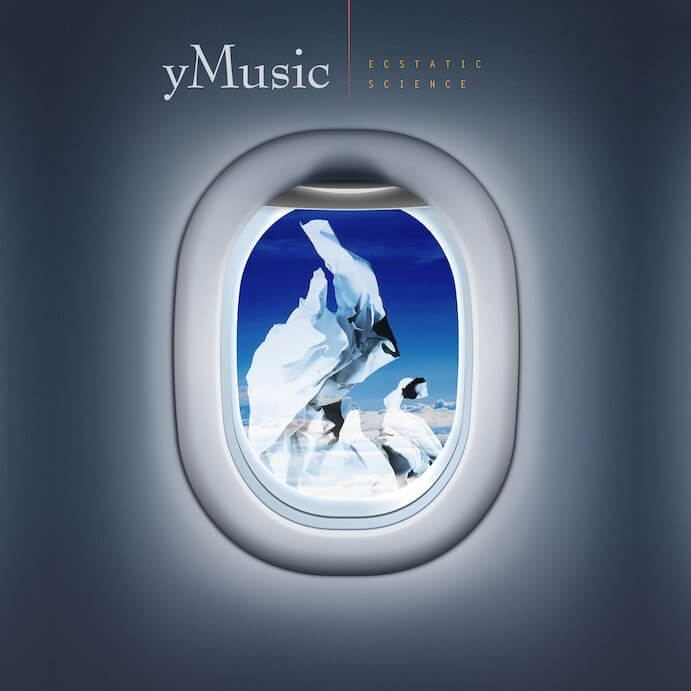For a band that plays to sold-out stadiums alongside musicians like Paul Simon, Bon Iver, and Ben Folds, yMusic’s performance on Ecstatic Science (New Amsterdam Records) shows a surprising degree of intimacy. Comprised of CJ Camerieri (trumpet), Alex Sopp (flute), Hideaki Aomori (clarinet), Rob Moose (violin), Nadia Sirota (viola), and Gabriel Cabezas (cello), yMusic’s performing forces are unusual but highly versatile. Ecstatic Science is a study in scope, moving from gargantuan walls of unrestrained sound to mixes that sound like they’re coming from inside your own head. From composer collaborators Gabriella Smith, Missy Mazzoli, Paul Wiancko, and Caroline Shaw, yMusic’s commissions (and Alejandro Venguer’s production) give a vehicle for their dazzling ability to experiment with—and even warp—perspective.
Tessellations by Gabriella Smith places listeners between two streams of music, meandering, brushing against one another, and separating again. The first stream begins with a persistent rhythm beaten on the body of a cello while a mass of rhythmic fragments accumulates rapidly alongside it. In the other stream, short, playful glissandi stretch and elongate to overtake static held tones in the trumpet and clarinet. Echoed in Aomori’s tapering from rough, pounding bass clarinet articulations to subtler, Vivaldian shimmer is the piece’s gradual unspooling from thick, ensemble textures to the solitary rhythm that began it.

yMusic–Photo by Graham Tolbert
Missy Mazzoli’s Ecstatic Science is the mirror image of the preceding track. Using the same materials (interlocking rhythms and glissandi), she turns the ensemble toward unity rather than fragmentation. The woodwinds’ disjunct polyrhythms spin into undulating contours, with each instrument following its own rhythmic subdivision. But yMusic’s careful balance leaves nothing in the foreground, drawing the listener away from the details and toward the whole. Thous&ths by Paul Wiancko is one of yMusic’s most unique, compelling tracks. The ensemble brings a full spectrum of subtle and detailed articulations to Wiancko’s score, animating its quirks and quips. When a muted soliloquy in the cello gives way to a series of wry, even sarcastic fanfares, the resulting adventure through off-kilter waltzes and pensive jazz ballads slingshots the listener between corners of the musical world that rarely touch. Thous&ths is the best kind of aural caricature: full of personality, quizzically raised eyebrows, and sly winks.
Caroline Shaw’s Draft of a High Rise achieves the architectural scope set out by its title, moving from abstract outline to a close-up view of the details, and finally through a dizzying tour of the whole. In the first movement, “Inked Frame,” homophonic textures highlight the ensemble’s elaboration and delicate detailing of Shaw’s melody. A countermelody of swirling, dovetailed interactions between flute, clarinet, and trumpet trails slightly behind, giving the impression of flowing, organic curves. In the second movement, “A Scribbled Veneer,” an ascending fifth motive is treated with an endless number of alternative endings. Sirota, Moose, and Sopp’s subtle and perpetually shifting embellishments force the perspective to zoom in closer. The end of the second movement plays with focus—how audible are the details as articulations fall out of sync and the ear is drawn toward the bigger picture once again? The final movement, “Their Stenciled Breath,” draws from the same motivic ideas as its earlier movements, but the rate of change is accelerated. Following a single line becomes mesmerizing, like trying to follow a single blade of a fan. The centrifuge eventually jerks to a close, casting off excess until all that is left is a pizzicato pulse.

Caroline Shaw–Photo by Kait Moreno
The album closes with Maré, a second selection by Gabriella Smith. Abruptly, the timbral world shifts to one of microtones and breathy harmonics, made familiar by allusions in earlier snippets of Shaw’s Draft of a High Rise and Smith’s Tessellations. The ensemble sits comfortably on the threshold of audibility, gradually increasing in volume and clarity. Aomori shines with high, gutsy glissandi and timbre trills. What begins as a frenetic and uneasy whirlwind increases in speed, density, and ferocity, reaching a breaking point in feral interjections from Aomori and Camerieri. As Sopp’s breathy flute guides the listener into relief (and a normal blood pressure), the piece collapses into wispy fragments and ends with the wash of noise where it started.
Ecstatic Science shows yMusic entering the new decade with eyes open to its new directions, though firmly grounded in an ensemble identity. Listening to the album in sequence can even suggest a narrative: a big, banging, and delightfully clamorous yMusic contracts to an intrepid and malleable yMusic. How will that group identity shift into their future? Does their sensitive performance of Smith’s Maré foreshadow a broadening of the ensemble’s standard fare? This balanced album seems to reach beyond what Nadia Sirota has identified as their niche: “groove-typed, hockety pieces.” With their veteran status and pieces like Wiancko’s and Smith’s to guide future commissioned composers, yMusic promises to grow into 2020 and beyond in unexpected and surprising ways.





















